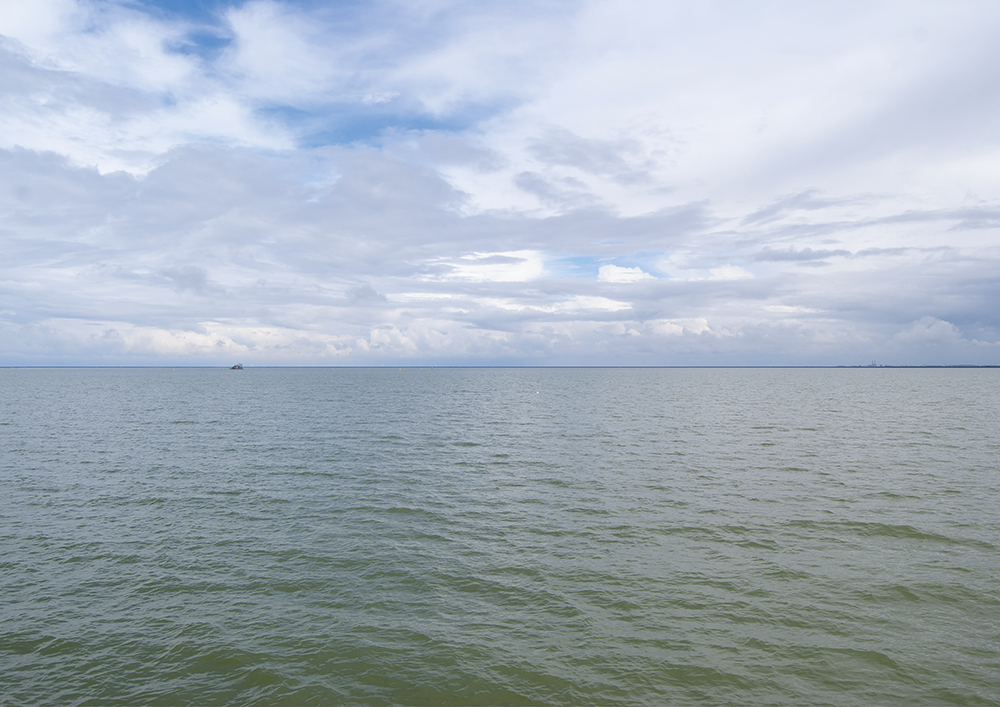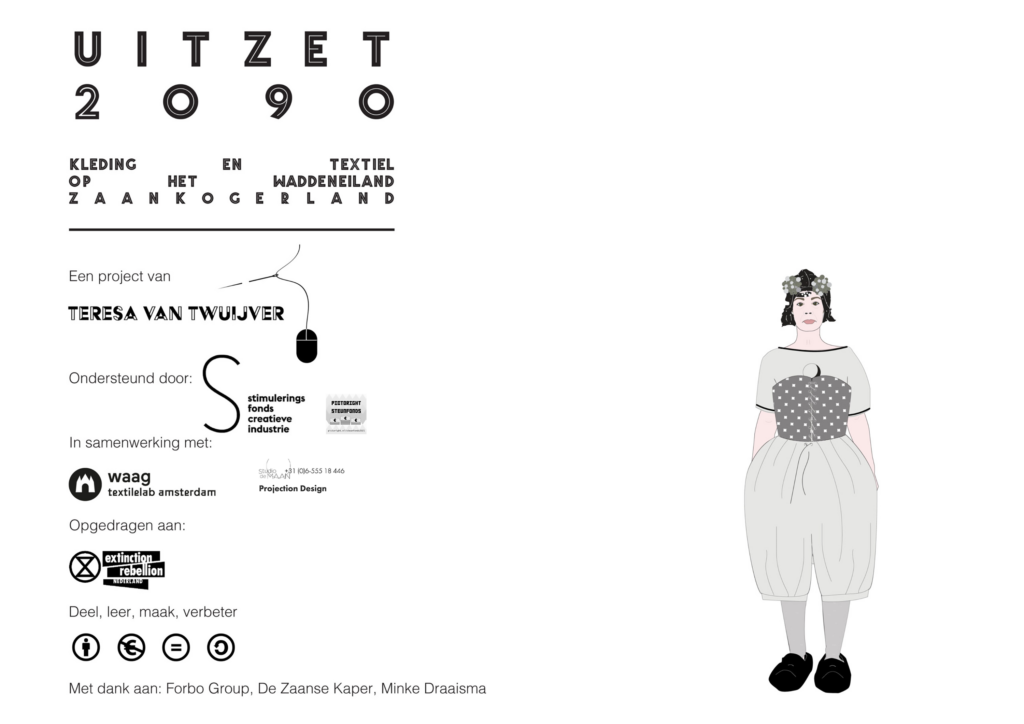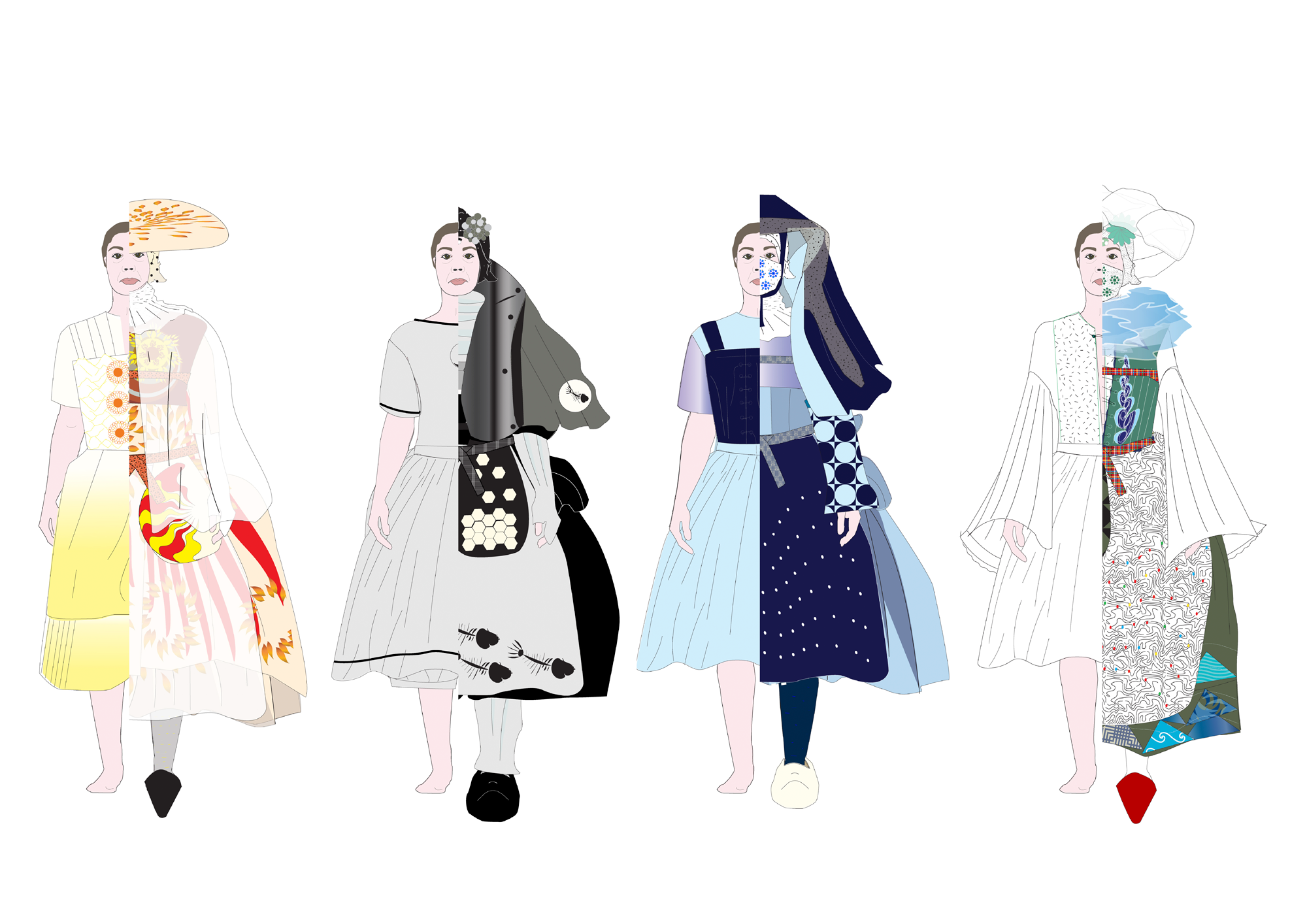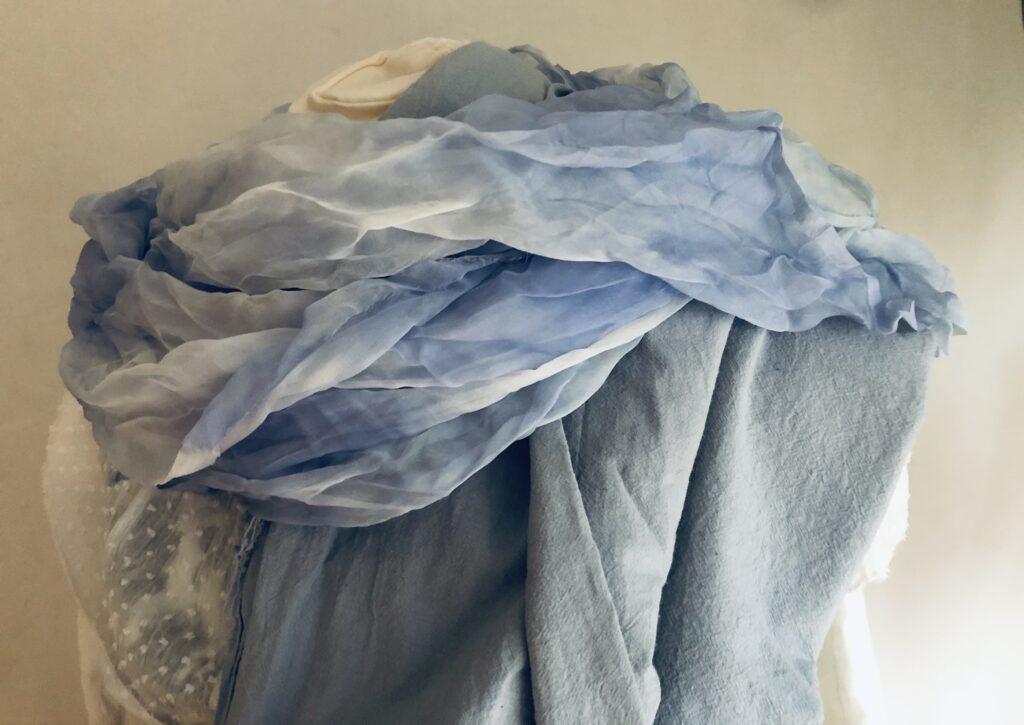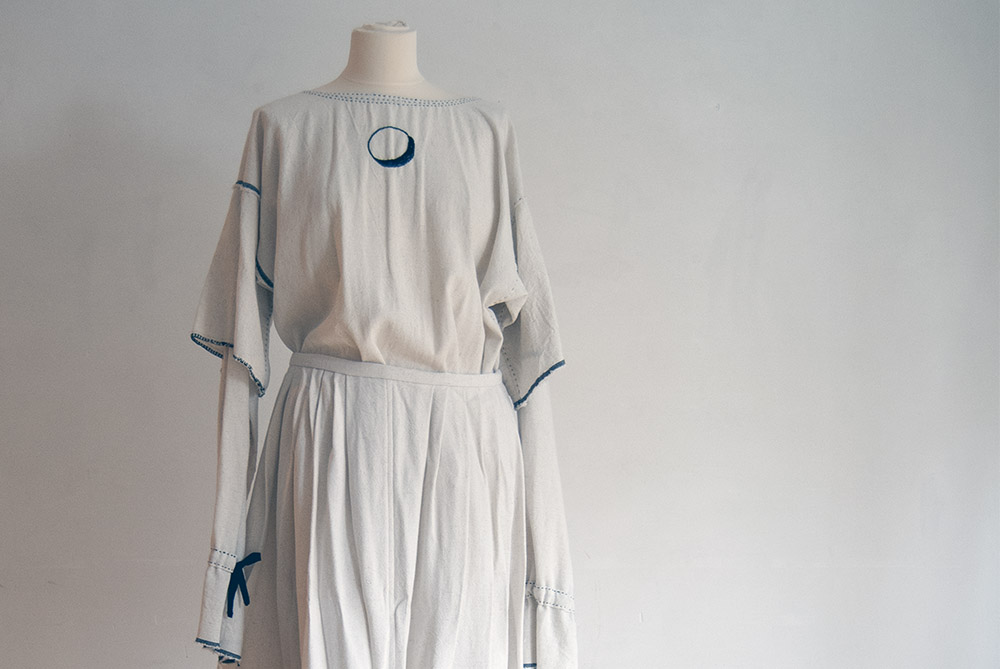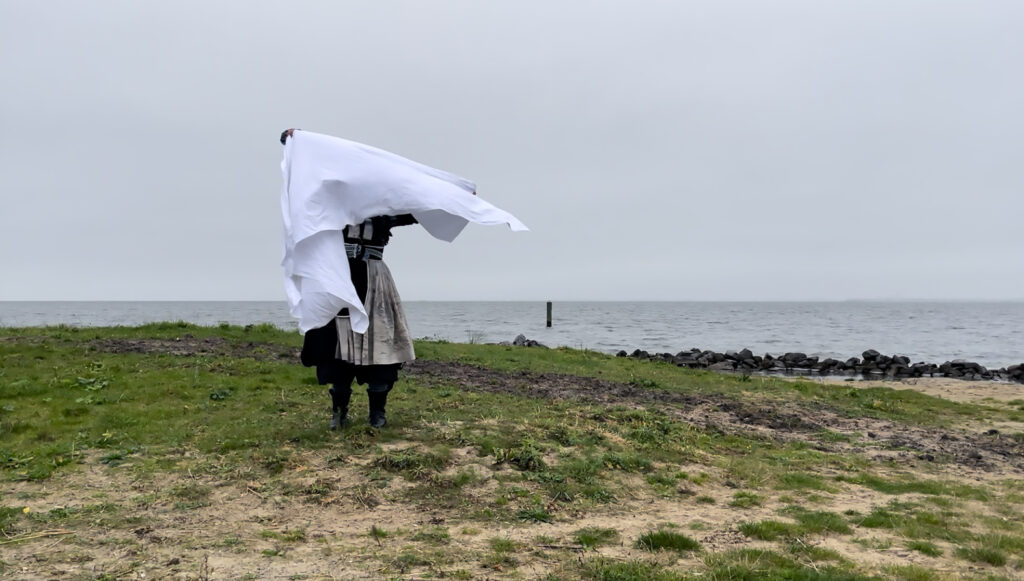Zaanse streekdracht na de Ergst Denkbare Overstroming
ENGLISH BELOW
Of het nu binnen een paar jaar is, of binnen een paar honderd: tenzij er onverhoopt een nieuwe ijstijd aanbreekt die het wassende water doet bevriezen, zal westelijk Nederland onder het Noordzeewater verdwijnen. Dit is de harde (en niet meer te stoppen) realiteit van de door menselijk handelen veroorzaakte klimaatopwarming.
Het project Zaankogerland (UITZET2090). Zaanse streekdracht na de Ergst Denkbare Overstroming stelt als centrale vraag hoe overlevers – pioniers op een nieuw Waddeneiland in de voormalige Zaanstreek in het jaar 2090 – zich dan zullen kleden. Wat dragen zij en wat maken zij, binnen de grenzen van schaars geworden materialen en verloren gegane kennis over textiel en kledingconstructie?
Een vrouw op het waddeneiland Zaankogerland, laten we haar Stientje Molenaar noemen, zal zeker vijf setjes kleding maken voor zichzelf. Voor elk seizoen van het jaar één, en één voor een speciale feestdag, waarvan een deel zal worden bewaard voor als ze doodgaat – haar bruidshemd is tevens haar doodshemd.
Ze naait bijna alles met naald en draad. En soms met een trapnaaimachine. Haar kleding is gemaakt van de weinige stof die zij kan krijgen, eenvoudig en zuinig in elkaar gezet met plooien, rimpels, smokwerk en vouwen om de kleding passend te maken. Stientje Molenaar gooit niets weg. Zij gebruikt en hergebruikt totdat iets onrepareerbaar versleten is. En dan gaat de ‘tod’ in de lappenmand als grondstof, bijvoorbeeld als vulling, of voor het maken van lompenpapier.
Kleuren en decoreren doet Stientje Molenaar met bloemen en wortels van inheemse planten die groeien op het aangeslibde land van het eiland en in de klei van een aantal polders die de Zaankogerlanders met ‘kranige moed’ hebben weten terug te veroveren op de zee. Digitaal aangestuurde machines, zoals de lasercutter en de 3D-printer (beperkt opererend op stroom opgewekt met wind), stellen haar in staat om respectievelijk overgebleven stukjes stof te verwerken tot ‘modules’ die een nieuw ‘weefsel’ opleveren, en om stevig hang- en sluitwerk uit te printen, precies genoeg en precies op maat.
Zaankogerland is nieuw land. Nieuw land na de Ergst Denkbare Overstroming. Nieuw land dat is ontstaan op de ruïnes van het oude, dat zowel is verbonden aan het oude als er volledig van is losgemaakt. Stientje Molenaar is een ‘nieuwe Zaanse’. Zij is, samen met haar leefgemeenschap van Zaankogerlanders, gericht op een nog onbekende werkelijkheid maar grijpt ook terug op de Zaanse tradities en streekdracht van eeuwen geleden. Zoals een boom zich voedt met wat zich in de bodem bevindt terwijl zij haar bladeren uitstrekt naar de uitdijende sterrenhemel, zo draagt pionier Stientje Molenaar op het maagdelijke Zaankogerland een traditionele Zaanse kaper.
Dit speculatieve designproject is ontstaan vanuit een grote behoefte aan nieuw land en een nieuw begin, in wat hopelijk kan worden beschouwd als de nadagen van het olietijdperk, het industriële kapitalisme en de internationale geldmarkt, de tijd van massaconsumptie, massatoerisme, massamedia en massamode, van ongekende en ongeremde massaverspilling, massavervuiling, massavernietiging en het massaal verpesten van de leefomgeving voor toekomstige generaties levende wezens.
Niets laat zien hoe mooi de wereld is, en hoe wonderlijk alles wat leeft, als nieuw land waar de tweede kans voor het oprapen ligt. Niets laat het hart meer opzwellen in liefde, als diepgevoelde dankbaarheid voor nog in leven zijn en opnieuw te mogen beginnen – en daarvoor om te beginnen kleding nodig te hebben.
Amsterdam, juli 2021
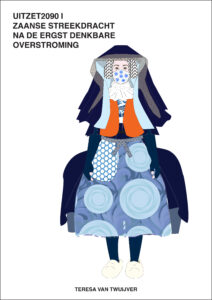
DOWNLOAD HET BOEK
GRATIS, klik op de cover
***
ENGLISH
Zaankogerland (HOPECHEST2090) – introduction
Zaans Regional Dress after the Worst Thinkable Flood
Whether it be within a few years or within a few hundred: unless a new ice age unexpectedly comes and freezes the rising water, the western Netherlands will be annexed by the North Sea. This is the harsh (and alas, as recent research asserts, unstoppable) reality of human-caused global warming and climate destruction.
The Zaankogerland (HOPECHEST2090) project, Zaans Regional Dress after the Worst Thinkable Flood, explores the central question of how survivors – pioneers on a new Wadden Island in the former Zaan region in the year 2090 – will dress. What do they wear and what do they make, within the limits of lost knowledge about textiles and clothing construction – one of the more dire problems of post-consumer society – and scarce materials.
A woman on the Wadden Island of Zaankogerland, let’s call her Stientje Molenaar, will make five sets of clothing for herself. One for each season of the year, and one for special occasions, part of which will be saved for when she dies – her bridal gown is also her chemise for in the coffin. Her clothes are made of the little fabric she can afford (some new, most old and secondhand) simply and sparingly put together with pleats, wrinkles, smocking and creases to make the clothes fit and also to make it possible to re-use the materials again.
Stientje Molenaar doesn’t throw anything away. She uses and reuses until something wears out beyond repair. And then the ‘tod’ goes into the rag basket as raw material, for example as filling, or for making Zaans rag paper. Stientje Molenaar dyes and decorates her textiles with flowers and roots from the immediate surroundings, from native plants that grow on the silted land of the island and in the clay of a number of polders that the Zaankogerlanders courageously managed to reclaim from the sea. Digitally controlled machines, such as the laser cutter and the 3D printer, enable her to respectively process leftover pieces of fabric into ‘modules’ that yield new weaves, and to print out sturdy ‘hinges and locks’ for clothes, precisely enough and exactly tailored.
Zaankogerland is new land. New land after the Worst Thinkable Flood. New land that has been spared amidst the ruins of the old, that is both attached to the old and completely detached from it. Stientje Molenaar is a ‘new Zaanse’. Together with her community of Zaankogerlanders, she focuses on a still unfamiliar reality, but also refers back to the Zaans traditions and regional dress from centuries ago. Just as a tree feeds on what is in the soil while stretching out its branches towards the expanding starry sky, pioneer Stientje Molenaar wears a traditional ‘Zaanse kaper’ (reinforced hood) that she made partly with digital technologies, on the newly formed island of Zaankogerland.
This speculative design project was born out of a deep longing for such new land and new beginnings, in what can hopefully be seen as the twilight years of the oil age, industrial capitalism and international financial markets, the age of mass consumption, mass tourism, mass media and mass fashion, of unprecedented and uninhibited mass waste, mass pollution, mass destruction and the senseless ruining of liveable environments for future generations of living beings.
Nothing shows how beautiful the world is, and how wonderful everything that lives, like a new land where a second chance is up for grabs. Nothing makes the heart swell in love more than a deep sense of gratitude for being alive and starting over—and needing clothes to begin with.
Amsterdam, juli 2021

